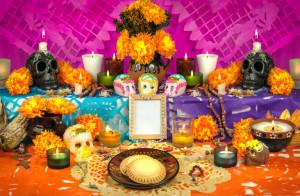
Halloween may be the biggest holiday in the fall, but Day of the Dead is important to Hispanics, which account for 17 percent of the population in the United States. In Mexico, it is a public holiday, but here in the United States, it’s taken a backseat to the festival of costumes and trick-or-treating. UNESCO considers Day of the Dead, or Dia de Muertos, an Intangible Cultural Heritage of History, and it’s important to understand why it holds such a place in Hispanic culture.
Three Days of Celebration
October 31, November 1, and November 2 are the three days that recognize the holiday. On the first day, the children build altars to invite the spirits of dead children to return for a visit. On November 1, it’s the adult spirits. November 2 is the day when the families go to graves of their ancestors and decorate them. Many will have a picnic at the site and remember anecdotes and events about their departed loved ones.
On this celebration at the cemetery, loved ones bring favorite foods and beverages of the departed and set out photos and other memorabilia. Some people spend all year looking for the perfect items to use for this decoration. Marigolds are considered the Flor de Muerto, or Flower of Dead, and attract the souls of the dead to the party.
Similar Traditions Around the World
There are many African cultures that visit the ancestor’s graves and leave food and gifts as part of the hunting ritual, asking for protection. In Chinese culture, people set aside a specific day to tend to the graves of their loved ones, much like the American Memorial Day. The Chinese calendar also has a day where the spirits come out and visit earth.
The Japanese Bon Festival is the Buddhist holiday that is held in August to honor the ancestors. In Korea, the holiday is called Chuseok, and people clean the tomb and perform worship rituals in the morning. They offer food and drink to the departed on this holiday. The Nepali tradition is Gai Jatra, for those who lost a family member the previous year. A portrait is decorated with bamboo and cloth before a cow leads the spirit into the afterlife.
Latin American cultures celebrate Day of the Dead much like Mexico, but in Guatemala, residents fly kites in addition to the other festivities. Haiti has all-night drum festivals that have developed from Roman Catholic and voodoo traditions. This is said to awaken Baron Samedi, the Loa of Death. In the Philippines, Day of the Dead is the second most important holiday after Christmas. Most people return to their hometown, and the government declares the dates special non-working holidays to give everyone a chance to travel.
Isn’t Day of the Dead a Religious Holiday?
Even though the holiday has some religious undertones as the heritage is part of the Catholic Church, it dates much farther back in Mexican history. At one time, the Aztecs celebrated for an entire month, remembering those who died. Since prehistoric times, families have found ways to honor those ancestors who meant so much to them.
Grief is overwhelming. Day of the Dead is a reminder that you can celebrate life and show respect to those you have lost. Setting aside one day to remember the good memories with your loved ones may have its roots in religion, but you don’t have to believe in the same gods to feel the pain of loss. You don’t even have to be Hispanic to have your own Day of the Dead celebration, but you can follow in the traditions of the Latinos in Mexico who certainly have ornate decorations and delicious foods to honor their loved ones.

